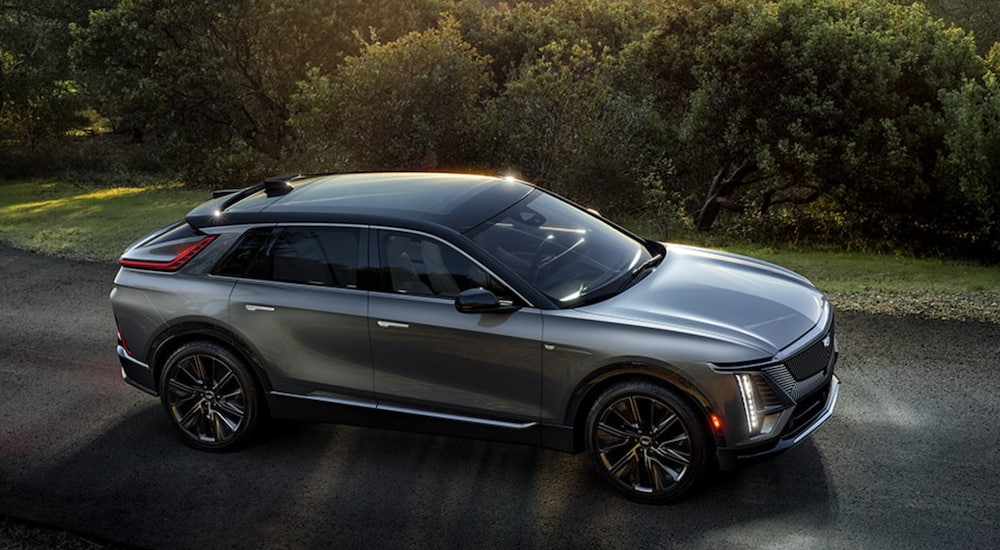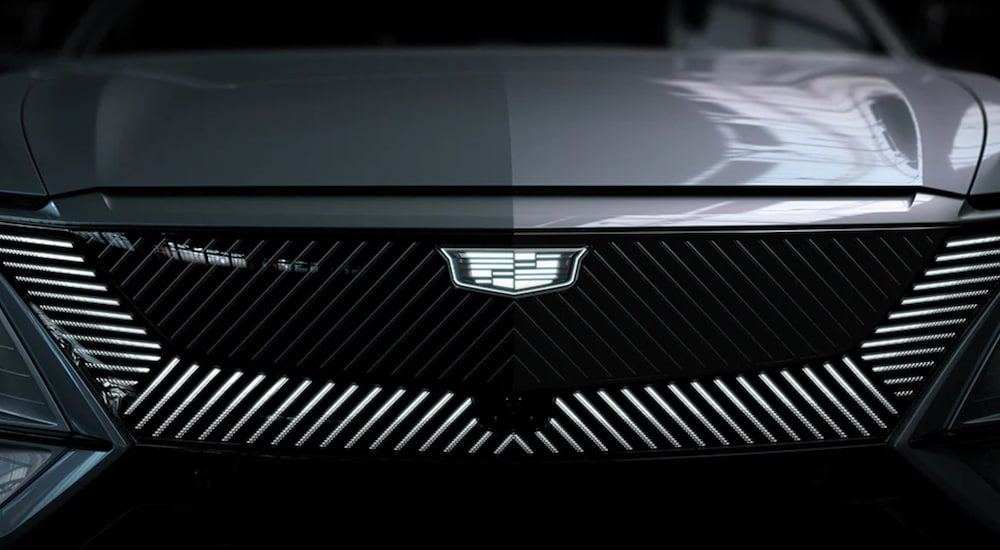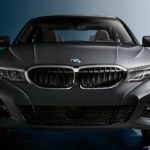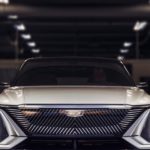As a company, GM has committed itself to meeting some fairly impressive goals involving its lineup of Electric Vehicles (EVs). They plan on having 30 EVs available globally by the end of 2025 across their different brands, and they’ve said they want to only offer electric models by 2035. One major part of this strategy is Cadillac, and the first of their impressive new Cadillac EVs is the LYRIQ, an all-electric luxury SUV that was first shown off as a sleek concept for what the future of luxury might look like.
Thanks to innovation in their development processes, however, not only is the upcoming production LYRIQ nearly identical to the concept vehicle that GM teased, but it’s going to be released ahead of schedule. Cadillac recently debuted the all-new fully-electric LYRIQ just ahead of a major marketing reveal during the Super Bowl – this was a full nine months ahead of their original schedule. All of this means they’re set to start taking reservations on the LYRIQ this year, with an intended release date in the summer of next year.
Faster Development from GM
Before taking a look at some of what the Cadillac LYRIQ has to offer, let’s look at how the development of this new model went. Originally, GM was planning a full reveal for the LYRIQ sometime either late this year or very early next year, with a goal of having the new electric SUV go on sale either in late 2022 or even early 2023. Traditional development and their estimates for how it would take made those dates seem like a reasonable timetable.
What happened, however, is that the development of the LYRIQ went much faster than they ever expected – putting their reveal in April a full nine months ahead of what they had planned. Perhaps most impressive about this, however, is that the auto industry was hit by delays and speed-bumps due to COVID-19 just like everyone else last year. So even in the midst of shutdowns, working from home, and a global pandemic, their engineers were able to get things done faster than they had expected. How did they do this?
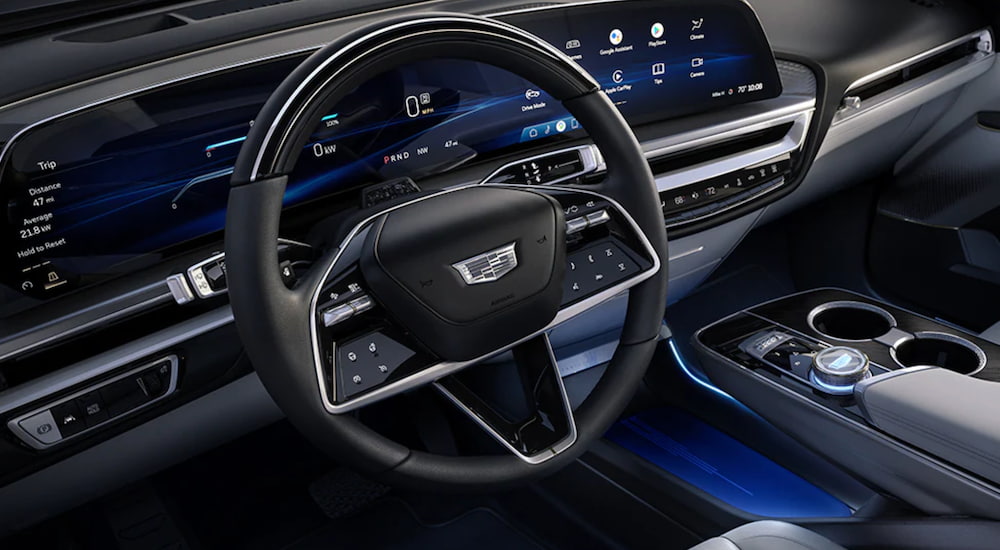
Virtual Testing and Validation
When developing a new vehicle, a lot of time is spent with planning and engineering. The designers have to come up with ideas for what it will look like, features it should have, performance goals, and all sorts of other things. This requires a tremendous amount of experience and technical know-how, and it’s why automotive engineers are so well respected within the industry. Once those ideas start to become a reality, then a whole lot of testing is required to iterate on those concepts and fine-tune them to perfection. All of that testing requires plenty of time, fabrication, engineering, and creating lots of prototypes.
But with the new software and technology that GM has developed and used, the testing process has been sped up significantly through virtualization. In other words, they can use computer simulations to test things rather than having to build everything and test it in the real world. There’s still real-world testing required, of course, but virtual testing and validation mean that they can try out ideas much faster and more easily than before. So rather than spend weeks or months developing and building something only to quickly realize it’s a dead-end or not quite right, they can figure that out much faster with their virtual tools.
GM has estimated that using these virtual tools has reduced engineering costs by $1.5 billion per year by speeding things up and allowing for a more optimized workflow. A lot of this savings is not only in man-hours, but the reduction in the building of prototypes and concepts that don’t go anywhere or prove ineffective. Best of all, with virtual design and testing, the engineers can look at systems and features that would be much more difficult to test or observe in the real world, giving them better insight than ever before.
Specifically, with the LYRIQ, GM has said their virtual development and testing process has enhanced a number of features, including cabin comfort in hot and cold environments, aerodynamics for optimal performance, and improved noise cancellation. These improvements, along with GM’s development of their new Ultium battery platform, came together to create this nine-month acceleration for the LYRIQ. So it’s a safe bet we’ll see them continue to improve upon and use these tools for future Cadillac models, as well as GMC and Chevy cars.
What Does the Cadillac LYRIQ Have to Offer?
With its new push toward a fully electric lineup, the LYRIQ is not just another new vehicle from Cadillac; it’s the new flagship for their fleet. This is the model that is set to showcase what the future of Cadillac is going to look like, and so far, it’s doing a very good job of it. Using GM’s Ultium battery platform, it features rear-wheel drive with a motor that delivers 340 hp and has a range of over 300 miles on a full charge.
Speaking of charging, the Cadillac LYRIQ can get about 76 miles of range from 10 minutes at a DC fast charging station, with support for at-home charging too. It features regenerative braking to boost range and performance, with Cadillac’s new Regen on Demand system, which lets the driver control how quickly the vehicle slows and stops in order to get the most out of regenerative braking. Plus, One-Pedal Driving makes it easy to enjoy a leisurely drive or just go for a ride.
The feature that’s probably getting the most attention, however, is the absolutely massive 33-inch LED display that runs across the front dashboard. This includes the driver’s cluster and a central infotainment screen all in one, giving you an unprecedented amount of screen space to keep track of everything you need to know. Combine that with an AKG Studio 19-speaker sound system with headrest speakers, along with the aforementioned next-generation active noise cancellation technology, and you get a truly impressive driving experience. Of course, since this is the new flagship Cadillac model, it also includes GM’s Super Cruise semi-autonomous driving technology, which will be featured on all Cadillacs going forward.
When Will It Be Available and How Much?
As I said earlier, the LYRIQ was originally slated for a public reveal either late this year or early next, with reservations to take place sometime in 2022 and release either toward the end of next year or even in early 2023. With everything moved forward, however, reservations are now planned to begin this September, with production beginning at the start of next year and availability starting in the first half of 2022. Best of all, the LYRIQ will launch starting at $58,795 MSRP, which is remarkable compared to some other luxury electric SUVs that start at $10,000 or more beyond that price.
This is only the beginning of Cadillac’s electric revolution. There’s a sedan called the CELESTIQ on the horizon, which could also be available sooner than expected due to these improvements to virtual design and testing. Not only is this the flagship for Cadillac’s new EV lineup, it marks the end of Internal-Combustion Engine (ICE) vehicles from the legendary luxury brand. While commenting on Cadillac’s future, Roy Harvey, vice president of Global Cadillac, said simply, “We won’t be selling ICE vehicles by 2030.” So it will be interesting to see where this goes in the years to come.
